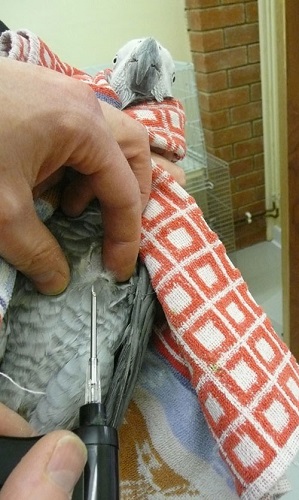The Importance of Microchipping Your Parrot
Posted by Microchipping, Parrot Safety, Leg Bands on 9/4/2025
Here?s why microchipping your Parrot is important.
Have you had your Parrot microchipped yet? Richard Jones of Avian Veterinary Services explains why it is so important to do this and why it is a lot safer than standard, traditional methods of identifying individual birds, such as leg bands.
For decades leg bands or rings have been used as the ?standard? method of identifying individual birds. Although relatively cheap and easy to apply, leg bands/rings have many disadvantages.
Leg Bands
First is the fact they can become caught on toys, cage bars/covers or even furniture and owners clothing. The bird will often panic when caught up and cause serious injury including fractures/dislocations, severe bleeding or even worse if the owner is not at home and the bird becomes suspended or trapped.
Secondly over time, debris may build up under the ring causing compression of the soft tissues, cutting off blood supply to the foot, which if left untreated may result in gangrene and loss of digits or even the whole foot.
Many birds also object to a foreign object placed on the limb which can lead to chewing of the area (an irritation which can progress to behavioural problems e.g. feather picking) or in the larger species e.g. Macaws compression of the ring itself resulting in significant damage.
In many cases, over time the numbers on the ring itself can wear off rendering it useless as an identification method and finally such a superficial form of identification is ?relatively? easy to remove if the bird is stolen.
Microchipping
In contrast, microchipping is a safe, effective and permanent means of identifying an individual bird that is difficult for the bird or a person to modify or damage.
The ?microchip? itself is a piece of silicone programmed with a specific numeric code, surrounded by a copper coil, encased in glass and coated in medical silicone to decrease the risk of migration and tissue reaction once implanted.
Database
The number on the microchip (which is stored on a database together with the owners contact details) is read by a scanner that emits an electronic signal in many cases without having to touch or restrain the animal. This signal energizes the coil and transmits the code back to the readers display.
The new ?mini? microchips that we now use in the vast majority of birds are inserted using a special implanter into the left pectoral muscle with, in most cases, the bird restrained conscious. We do on occasion recommend a light sedation to ensure accurate placement; in birds weighing less than 200g or particularly fractious patients.
In experienced hands complications are extremely rare but may include localized pain, bleeding, infection or migration of the chip if not inserted properly into the muscle.
This system has been tried and tested now for over 20 years in hundreds of different species and with most veterinary practices, animal charities and rescue centres in possession of a scanning devise, countless lost animals and birds have been successfully reunited with their families.
Avian Vets
At Avian Veterinary Services, we highly recommend microchipping to all our clients and if you require further information do not hesitate to contact us by phone on 01606 350 410 or email ? info@avianveterinaryservices.co.uk

Photo Credit: Micro and mini chips from petDetect.
Find an avian vet nearest to you here.



